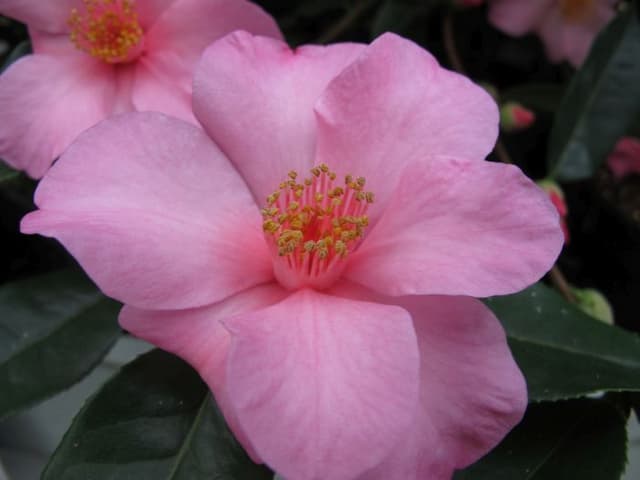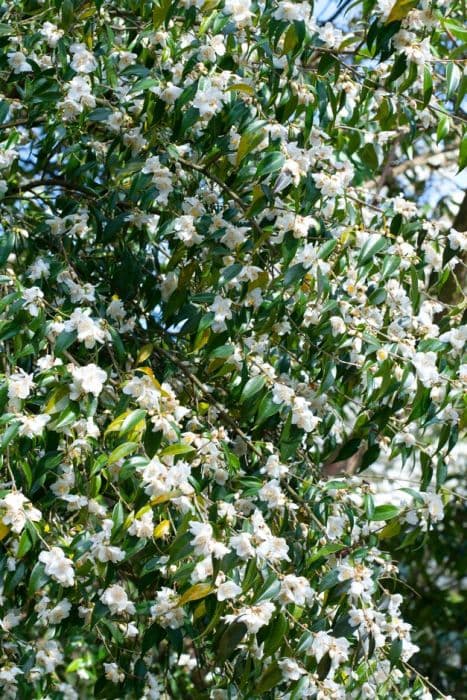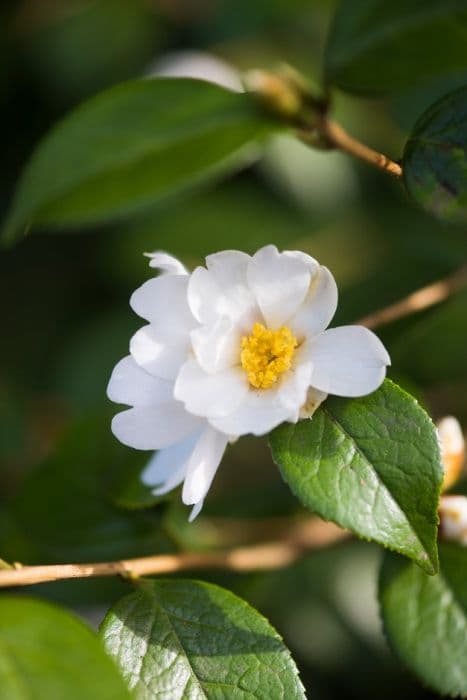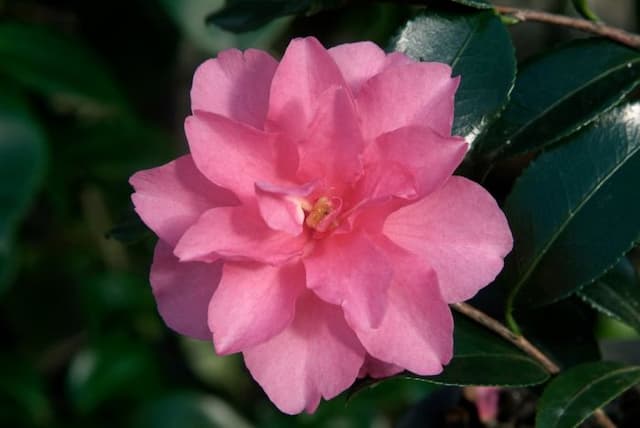Williamsii Camellia Camellia × williamsii 'Rose Parade'

ABOUT
The Camellia 'Rose Parade' is a visually stunning plant celebrated for its profuse display of ornate flowers. The blossoms are a gorgeous shade of pink, with numerous petal layers that create a full, peony-like appearance. The petals are elegantly arranged and may exhibit a soft, velvety texture that beckons to be touched. Amidst the lush green foliage, these blooms stand out with their substantial form and vibrant hue. The leaves of the 'Rose Parade' are glossy and dark green, offering a lustrous backdrop that accentuates the floral show. As the flowers mature, they unfurl to reveal bright yellow stamens at their center, which adds a striking contrast to the pink petals and attracts pollinators. The overall impression of the Camellia 'Rose Parade' is one of classic beauty, as it graces gardens with its romantic and colorful presence throughout its blooming season.
About this plant
 Names
NamesFamily
Theaceae
Synonyms
Williamsii Camellia, Rose Parade Camellia
Common names
Camellia × williamsii 'Rose Parade'.
 Toxicity
ToxicityTo humans
The plant known as Camellia is generally considered non-toxic to humans, and there is no widespread documentation of adverse effects from ingesting parts of this plant. Nonetheless, it is always advisable to keep any plant material out of the reach of small children and to not consume plant parts without verifying their edibility, as individual sensitivities or allergic reactions could occur.
To pets
The plant known as Camellia is generally considered non-toxic to pets, including cats and dogs. There is no significant evidence that ingesting parts of this plant would result in poisoning or severe adverse effects. However, it is always best practice to prevent pets from chewing on plants, as they might cause mild gastrointestinal upset or an obstructive risk in some cases due to the physical nature of the plant material.
 Characteristics
CharacteristicsLife cycle
Perennials
Foliage type
Evergreen
Color of leaves
Dark green
Flower color
Pink
Height
6-12 feet (1.8-3.7 meters)
Spread
6-10 feet (1.8-3 meters)
Plant type
Shrub
Hardiness zones
7-9
Native area
China Japan
Benefits
 General Benefits
General Benefits- Ornamental Appeal: Produces attractive semi-double flowers with shades of pink that enhance garden aesthetics.
- Year-Round Interest: Evergreen foliage ensures that the plant contributes to the garden's beauty throughout the year.
- Durability: Known for being disease and pest-resistant, reducing the need for chemical interventions.
- Shade Tolerance: Can grow well in partial shade, offering flexibility in garden design and placement.
- Low Maintenance: Requires minimal pruning and care once established, making it ideal for busy gardeners.
- Long Blooming Season: Flowers from late winter to early spring, providing color during a time when few other plants bloom.
- Wildlife Attraction: Attracts pollinators such as bees, which are beneficial for the garden ecosystem.
 Medical Properties
Medical PropertiesThis plant is not used for medical purposes.
 Air-purifying Qualities
Air-purifying QualitiesThis plant is not specifically known for air purifying qualities.
 Other Uses
Other Uses- Artistic inspiration for painters and photographers who capture its beauty in their work.
- Motif in textile designs, where the patterns of 'Rose Parade' camellias are printed on fabrics for clothing or home decor.
- In floral crafts such as making corsages or boutonnieres, where the vibrant flowers provide a stunning focal point.
- As natural confetti in weddings or celebrations, camellia petals can be tossed instead of synthetic confetti for an eco-friendly alternative.
- Culinary decoration, as the non-toxic petals can be used to adorn cakes or dishes for an elegant touch.
- Bonsai cultivation, where enthusiasts may train Camellia × williamsii 'Rose Parade' plants into miniature form.
- Theme in garden competitions, where growers showcase their 'Rose Parade' specimens for accolades.
- Cultural symbolism, as the camellia often represents love and affection in various cultures and can be used in ceremonies.
- Collectors of camellia varieties, where 'Rose Parade' is coveted for its unique coloration and form.
- Educational tool in horticulture classes to demonstrate plant breeding and hybridization techniques.
Interesting Facts
 Feng Shui
Feng ShuiThe Williamsii Camellia is not used in Feng Shui practice.
 Zodiac Sign Compitability
Zodiac Sign CompitabilityThe Williamsii Camellia is not used in astrology practice.
 Plant Symbolism
Plant Symbolism- Adoration: The 'Rose Parade' variety of Camellia often symbolizes deep adoration, due to its lush, rose-like flowers that evoke a sense of warmth and affection.
- Perfection: With its exquisite form and pristine petals, Camellias signify the pursuit of perfection in many cultures.
- Longevity and Faithfulness: Camellias are evergreen and long-lived, representing a steadfast nature in relationships and a wish for a long, healthy life.
- Desire: The Camellia's captivating beauty can also represent an object of desire, for those things that the heart yearns deeply for.
 Water
WaterThe Williamsii Camellia, or 'Rose Parade', prefers consistent moisture and should be watered deeply once a week, especially during dry periods. It is important to avoid overhead watering to prevent petal blight, and instead water at the base of the plant. The soil should be kept moist, but not waterlogged. Depending on the climate and the size of the plant, usually around 1 to 1.5 gallons of water per week will suffice. During the warmer months, increase the frequency of watering to maintain soil moisture levels.
 Light
LightThe Williamsii Camellia thrives best in partial shade to filtered sunlight conditions. It should be placed in a location that receives morning sun and afternoon shade to protect it from the intense midday heat. Direct, hot sunlight can cause the leaves to scorch and should be avoided.
 Temperature
TemperatureThe Williamsii Camellia is comfortable in temperatures ranging from 40 to 85 degrees Fahrenheit. It can withstand brief periods outside this range but prefers not to be subjected to temperatures below freezing or above 90 degrees Fahrenheit for extended periods. The ideal temperature range for optimal growth and flowering is between 60 and 70 degrees Fahrenheit.
 Pruning
PruningPruning the Williamsii Camellia is essential to maintain its shape, encourage bushier growth, and enhance flowering. It should be pruned immediately after blooming has finished, typically in late winter or early spring before the new growth starts. Remove any dead or weak branches, and thin out dense areas to allow light and air to reach the inner parts of the plant.
 Cleaning
CleaningAs needed
 Soil
SoilThe Williamsii Camellia prefers slightly acidic, well-drained soil with pH between 5.5 and 6.5. A recommended soil mix would be one part peat moss, one part perlite, and one part loamy garden soil to ensure adequate drainage and aeration while providing some organic matter and moisture retention.
 Repotting
RepottingThe Williamsii Camellia should be repotted every 2-3 years to ensure it is not root-bound. Younger plants may require more frequent repotting, while established, larger specimens can be repotted less often.
 Humidity & Misting
Humidity & MistingWilliamsii Camellias thrive in moderate to high humidity levels, ideally around 50-60%. They benefit from a humid environment but should not be subjected to prolonged wetness which can lead to fungal issues.
 Suitable locations
Suitable locationsIndoor
Place in bright, indirect light; keep humid and water with soft water.
Outdoor
Plant in dappled shade with shelter from strong winds; mulch well.
Hardiness zone
7-9 USDA
 Life cycle
Life cycleCamellia x williamsii 'Rose Parade', commonly known as Rose Parade Camellia, begins its life cycle as a seed, developing within the spent flower's ovary until it matures and falls to the ground or is collected for propagation. After germination, which requires a warm, moist environment, the seedling emerges, developing into a young plant with a set of true leaves, establishing its root system. Gradually, the young Rose Parade Camellia enters a vegetative state, characterized by the growth of glossy, evergreen leaves and a woody stem, over several years. The plant will reach maturity and start its initial blooming phase, usually within a few years, producing the signature large, rose-pink, semi-double flowers for which it is named. The blooming season for the Rose Parade Camellia typically occurs in winter to spring, after which the pollinated flowers will develop into seed pods if conditions allow. Finally, the mature plant enters a period of annual growth and blooms, which can span for decades with proper care, until it eventually senesces and dies.
 Propogation
PropogationPropogation time
Spring-Early Summer
The most popular method of propagating Camellia × williamsii 'Rose Parade', commonly known as Rose Parade Camellia, is through semi-hardwood cuttings. This process is typically done in late summer to early fall. To propagate, one should select healthy semi-hardwood stems from the current year’s growth and cut a piece about 4 to 6 inches long. The lower leaves are removed, and the cut end is dipped in rooting hormone to encourage root development. The cutting is then placed in a well-draining potting mix and kept in a humid environment with indirect light until roots have established, which usually takes several weeks. It is important to maintain even moisture during this time, but avoid waterlogging which can lead to rot. Once rooted, the new plants can be gradually acclimatized to outdoor conditions and eventually planted out in the garden.









